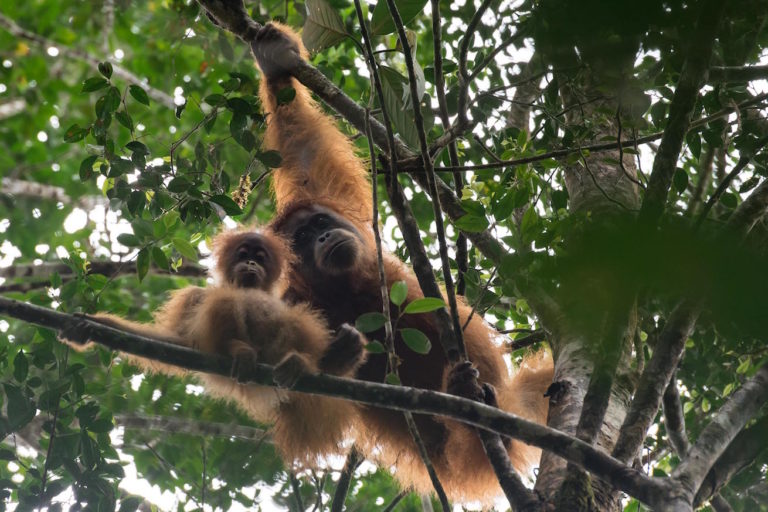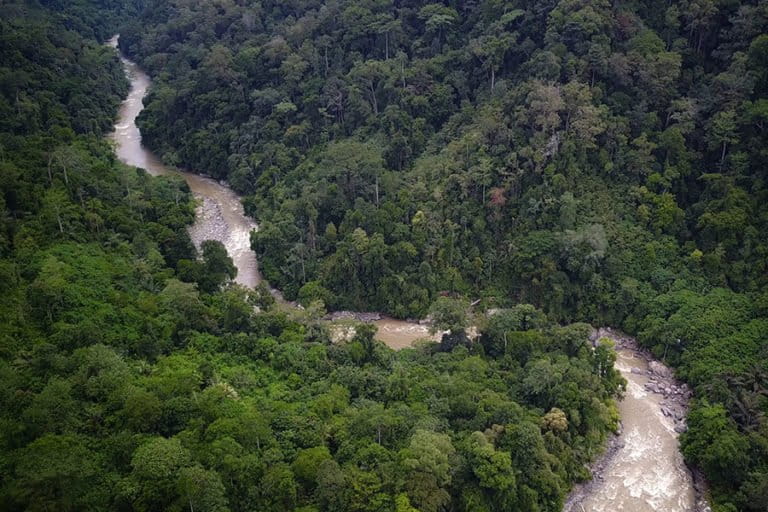- A controversial hydropower dam that threatens the only known habitat of the world’s rarest orangutan species is unnecessary from both climate and economic aspects, a new report says.
- The report, commissioned by a group campaigning against the Batang Toru dam in Indonesia but drawing on official government data, says the dam will do little to connect the few remaining isolated communities in the region to the grid.
- It also says the region’s power needs will be better met, and at lower cost, by a slate of other projects already in the works, including expansion of existing gas turbine plants.
- The report says the dam developer’s claims of an overall reduction in Indonesia’s CO2 emissions are “significantly overstated,” and that builder Sinohydro has a track record of faulty dam construction in other countries.
JAKARTA — Proponents of a hydropower plant to be built in the only known habitat of a critically endangered orangutan species say it’s important for meeting the future energy needs of northern Sumatra. But a new report says this region of Indonesia is already almost fully electrified, and that the new plant will do virtually nothing to improve that.
The report from energy consultancy Brown Brothers Energy and Environment (B2E2) was commissioned by various NGOs, including environmental advocacy group Mighty Earth, which has been a vocal opponent of the dam. It cites official data to show that North Sumatra province, home to the Batang Toru forest where the dam and power plant are to be built, already has one of the highest electrification rates in Indonesia: nearly 96% of the population had basic and stable access to electricity in 2016, compared to the more developed major provinces of East Java (89%) and Bali (92%).
Of the 319 wards in North Sumatra still without grid electricity, nearly half are on the island of Nias. The island’s electricity infrastructure was knocked out by a series of devastating earthquakes and tsunamis in 2004 and 2005, and authorities continue to struggle to get it running properly. Without a working grid, any power generated by the dam project would be immaterial to Nias, the new report says.
Residents of Nias “will remain unaffected no matter how much power generation is added in the mainland of North Sumatra,” David Brown, the report’s author, said in Jakarta.

‘Inflated’ emissions reduction
Construction is already underway on the 510-megawatt Batang Toru dam. The project site falls within the habitat of the Tapanuli orangutan (Pongo tapanuliensis), a species that was only described in 2017, and was immediately declared critically endangered and the world’s rarest great ape species.
Only 800 of the animals survive in a tiny tract of forest less than one-fifth the size of the metropolitan area that comprises Indonesia’s capital, Jakarta. Conservationists estimate that a loss of more than 1 percent of the population per year will be disastrous for the species, which has a low reproduction rate and is highly sensitive to disruptions in its habitat. Construction activity for the dam has already driven some of the orangutans out of the project area and into nearby oil palm plantations.
When the project was proposed in 2012, North Sumatra was experiencing frequent power shortages and rolling blackouts. But that changed just a few years later.
“The availability of electricity began to surpass peak demand in 2017,” Brown said. “And this new surplus greatly reduced the number of blackouts.”
A major factor in that turnaround was the arrival of a ship-mounted power plant, or powership, that the Indonesian government rented from Turkish company Karadeniz. The ship, featuring a 240 MW gas-fired generator, has been contracted to power Medan, the North Sumatra capital, through 2022.
The B2E2 report also identifies 80 other power plants — ranging from geothermal to coal to mini hydro — planned for North Sumatra province alone that would render the $1.6 billion Batang Toru plant “wholly unnecessary to meet North Sumatra’s electricity demand in the future.”
These other projects include three new turbines at a planned gas-fired power plant that are expected to come online between 2022 and 2028, and that will generate a combined 800 MW.
Proponents, including project developer PT North Sumatra Hydro Energy (PT NSHE), say bringing the Batang Toru plant online will cut Indonesia’s carbon dioxide emissions reduce emissions by 1.6 million to 2.2 million tons per year. But the report says that “even the smallest estimate of greenhouse gas reductions promised by Batang Toru’s backers are inflated on the order of 33 to 55 percent.”
Brown said the claim was based on the assumption that the hydropower dam would replace the average carbon output of all utilities nationwide. “The problem is that the idea of Batang Toru replacing an average of all power plants in Indonesia is an imaginary construction,” he said. “What is real is that Batang Toru, if built, would replace specific power plants in North Sumatra.”
“My report contends that it is better for PLN to build or expand any of these other 80 because, in contrast to Batang Toru, these other 80 do not directly threaten the low elevation nursery forest of the Tapanuli orangutan.”
The three new gas turbines, in particular, would cost a third the price of the dam to build, produce more peak power, not harm orangutan habitat, and keep CO2 emissions low through more efficient turbine technology, the report says.
“Bottom line,” it says, “Batang Toru’s backers are significantly overstating its greenhouse gas emissions benefits.”

‘Plagued with faulty construction’
The report also highlights the track record of Sinohydro, the Chinese state-owned company contracted to build the dam.
“Dams built by them have been plagued with faulty construction,” Brown said. “Sinohydro was caught on film watering down cement when constructing the Bakun dam in Sarawak, Malaysia.”
The Coca Codo Sinclair dam that it built in Ecuador also had construction problems, with more than 7,000 cracks appearing in its machinery within months of completion. An official report by the Ecuadoran government was critical of Sinohydro’s “irresponsible and incomprehensible” use of substandard building materials and construction methods.
“The Chinese used bad-quality steel and fired inspectors who said to change it,” Ecuador’s former energy minister, Fernando Santos, said in 2018.
Part of the structure may have to be demolished and rebuilt, at a cost of hundreds of millions of dollars. Santos said the $2.8 billion dam was overpriced and of poor quality, and had left the country in debt to China.
The Coca Codo Sinclair dam is also located near an active volcano, and geologists warn an earthquake in the area could have devastating effects.
In Indonesia, activists and scientists have raised similar alarms about the Batang Toru project, which sits near a known tectonic fault. Earthquakes are a common occurrence in Indonesia generally, and in northern Sumatra in particular. In 2008, a magnitude 6 quake struck just 4 kilometers (2.5 miles) from the site of the dam.
Officials from developer PT NSHE have acknowledged the earthquake risk, but critics say there are no mitigation plans based on this risk included in the environmental impact analysis submitted to authorities.

‘Huge waste of money’
PT NSHE has responded to the report by questioning Brown’s credibility, saying he isn’t an expert in Indonesia’s energy sector. (Brown served as an adviser to BHP Billiton, the world’s biggest mining company, when it operated in Indonesia; was the World Bank’s senior adviser on the Extractive Industries Transparency Initiative, or EITI; and has consulted on Indonesia’s natural and extractive resource sectors for the Asian Development Bank and the Organization for Economic Cooperation and Development, among others.)
“He’s only asked to voice the opinion of his client, Mighty Earth,” PT NSHE spokesman Firman Taufick said as quoted by local media. Firman also criticized Mighty Earth, saying the campaign group did not have Indonesia’s best interests at heart.
“Anyone knows who they are, their motivation and interest … What’s clear is that their interest is not for Indonesia,” he said.
Mighty Earth great apes program director Amanda Hurowitz refuted the claim, saying it has worked for years to highlight the importance of protecting Indonesia’s environment and supporting the development of its economy. She said the Batang Toru dam, however, was “a huge waste of money that threatens local communities and would primarily … benefit a Chinese construction company with a terrible record.”
With the dam being such a risky project, the hydropower plant would not only be bad for the Tapanuli orangutan, but also for Indonesia’s reputation, Hurowitz added.
“The dam company is out of arguments to defend this wasteful project, so the only thing it can do is attack those who expose the disingenuous marketing behind this project,” she said.
Brown, meanwhile, defended his report by saying he relied on official Indonesian government data, primarily from state-owned utility PLN, to analyze the claims of the dam’s proponents.
“My report would not have been possible if I had not been able to use PLN’s plans to see into North Sumatra’s energy future,” he said. “The findings of my report are built almost entirely upon PLN’s most recent 10-year planning document, the 2019 RUPTL.
“My report says, in essence, that PLN got it almost entirely right, and that out of the 81 power plants that PLN has proposed for construction or expansion in North Sumatra in the coming decade, only one needs to be removed from that list: Batang Toru.”
Banner image: A Tapanuli orangutan in the Batang Toru forest in northern Sumatra, Indonesia. Image by Matt Senior.
FEEDBACK: Use this form to send a message to the author of this post. If you want to post a public comment, you can do that at the bottom of the page.














